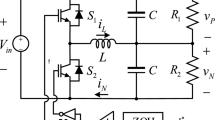Abstract
In this paper, a digital vector impedance half-bridge meter based on virtual instruments is designed, implemented and tested. Here, not only the accuracy of the magnitude of the impedance is considered but, more importantly, its phase measurement accuracy. The meter utilizes a four-voltmeter method which is a basic modification of the well-known three-voltmeter method. The half-bridge is constructed with commercially available data acquisition (DAQ) board in the form of peripheral control interconnect cards incorporated in personal computers. The DAQ board is used only to acquire the voltages instead of using four separate voltmeters, while the excitation signal is produced by an integrated circuit signal generator. The main error in this method arises from the error in measuring the voltage values. Since the resolution of the DAQ board used here is 16 bits; expect that absolute errors due to A/D conversion will be around 0.305 mV for ±10 V range. Detailed error analysis of the method is included in the context of the paper. It is found that the errors in the impedance magnitude is fairly small and relatively less sensitive on the resolution of the voltmeters because of the relative measurements in the half bridge with a precise reference resistance. The original three voltmeter vector impedance meter has relatively large error in the phase especially in the small phase angles. To decrease the phase error to an acceptable range, one has to increase the resolution of the voltmeter appreciably, which makes them expensive. The other solution to reduce the error in the phase angle with less cost is to add a fourth voltmeter which acquires directly the small phase angles. In this case, it is found that, a much lower resolution voltmeter can be utilized while achieving an acceptable measurement accuracy of the impedance.











Similar content being viewed by others
References
O. T. Ogunnika, M. Scharfstein, R. C. Cooper, H. Ma, J. L. Dawson and S. B. Rutkove, A handheld electrical impedance myography probe for the assessment of neuromuscular disease, IEEE International Conference of the Engineering in Medicine and Biology Society, EMBS, Canada(2008), 3566–3569.
M. Scharfstein, A reconfigurable electrode array for use in rotational electrical impedance myography, Doctoral dissertation, Massachusetts Institute of Technology, 2007.
M. Mancio, J. Y. Zhang and P. J. M. Monteiro, Nondestructive surface measurement of corrosion of reinforcing steel in concrete, Canadian civil engineer, 21(2) (2004) 12–14.
D. Joshi, D. Bhatnagar, A. Kumar and R. Gupta, Direct measurement of acoustic impedance in liquids by a new pulse echo technique, MAPAN-J. Metrol. Soc India, 24 (2009) 215–224.
P. K. Dubey, S. Rajagopalan, V. R. Vyaghra, V. M. Pendsey and S. J. Sharma, High resolution ultrasonic attenuation measurement in pulse-echo setup, MAPAN-J. Metrol. Soc India, 23 (2008) 245–252.
N. Garg, M. Singh, O. Sharma and V. Mohanan, Current status of acoustic measurement standards at National Physical Laboratory of India (NPLI), New Delhi-Part 1: sound pressure, MAPAN-J. Metrol. Soc India, 22(2) (2007) 77–90.
D. Joshi, A. Kumar, R. Gupta and S. Yadav, sensitivity enhancement of concurrent technique of acoustic impedance measurement, MAPAN-J. Metrol. Soc India, 28(2) (2013) 79–83.
J. Santos and P. Ramos, DSPIC-based impedance measuring instrument. Metrology and Measurement Systems, 18(2) (2011)185–198.
Agilent 4287A RF LCR Meter 1 MHz–3 GHz, Data Sheet (October 2004), www.agilent.com.
H. Haruta, The impedance measurement handbook: a guide to measurement technology and techniques, Agilent Technologies, (2000).
T. Radil, P. M. Ramos and A. Cruz Serra, Impedance measurement with sine-fitting algorithms implemented in a DSP portable device. IEEE Trans. Instrumentation and Measurement, 57(1) (2008) 197–204.
P. M. Ramos, F. M. Janeiro, M. Tlemçani and A. C. Serra, Recent developments on impedance measurements with DSP-based ellipse-fitting algorithms, IEEE Trans. Instrumentation and Measurement, 58(5) (2009) 1680–1689.
P. Ramos, F. Janeiro and T. Radil, Comparative analysis of three algorithms for two-channel common frequency sinewave parameter estimation: ellipse fit, seven parameter sine fit and spectral sinc fit. Metrology and Measurement Systems, 17(2) (2010) 255–270.
G. Lentka, Using a particular sampling method for impedance measurement, Metrol. Meas. Syst., 21(3) (2014) 497–508.
L. A. Marzetta, An evaluation of the three-voltmeter method for ac power measurement, IEEE Trans. Instrumentation and Measurement, 21(4) (1972) 353–357.
P. Arpaia, F. Avallone, A. Baccigalupi, C. De Capua and C. Landi, Power Measurement. Webster, J. G. (eds.). The Measurement Instrumentation and Sensors Handbook, CRC Press LLC, Boca Raton, (1999).
B. C. Waltrip and N. M. Oldham, Digital impedance bridge, IEEE Trans. Instrumentation and Measurement, 44(2) (1995) 436–439.
L. Callegaro and V. D’Elia, Automated system for inductance realization traceable to ac resistance with a three-voltmeter method, IEEE Trans. Instrumentation and Measurement, 50(6) (2001) 1630–1633.
J. Bohacek and R. Sedlacek, Calibration of inductance standards, IEEE proc. Precision Electromagnetic Measurements Digest,(2004) 37–38.
L. Callegaro, G. Galzerano and C. Svelto, Precision impedance measurements by the three-voltage method with a novel high-stability multiphase DDS generator. IEEE Trans. Instrumentation and Measurement, 52(4) (2003) 1195–1199.
V. Dumbrava and L. Svilainis, The automated complex impedance measurement system. Electronics and electrical engineering, 4(76) (2007).
J. Bohacek, T. Jursa and R. Sedlacek, Calibrating standards of mutual inductance, IEEE Proc. Instrumentation and Measurement Technology, IMTC, 2(2005)1002–1004.
A. Muciek and F. Cabiati, Analysis of a three-voltmeter measurement method designed for low-frequency impedance comparisons, Metrology and Measurement Systems, 13(1) (2006) 19–33.
S. A. Macintyre, The measurement, instrumentation and sensors handbook, CRC press, 1999.
S. Garrod, D/A and A/D Converters. Dorf, R. C. (eds.). The electrical engineering handbook, CRC Press LLC, Boca Raton, 2000.
J. McLucas, Precision peak detector uses no precision components, EDNEurope, 49(9) (2004) 66.
Author information
Authors and Affiliations
Corresponding author
Rights and permissions
About this article
Cite this article
Zekry, A., Ibrahim, A., Atallah, A. et al. Four Voltmeter Vector Impedance Meter Based on Virtual Instrumentation. MAPAN 31, 159–167 (2016). https://doi.org/10.1007/s12647-016-0172-6
Received:
Accepted:
Published:
Issue Date:
DOI: https://doi.org/10.1007/s12647-016-0172-6




